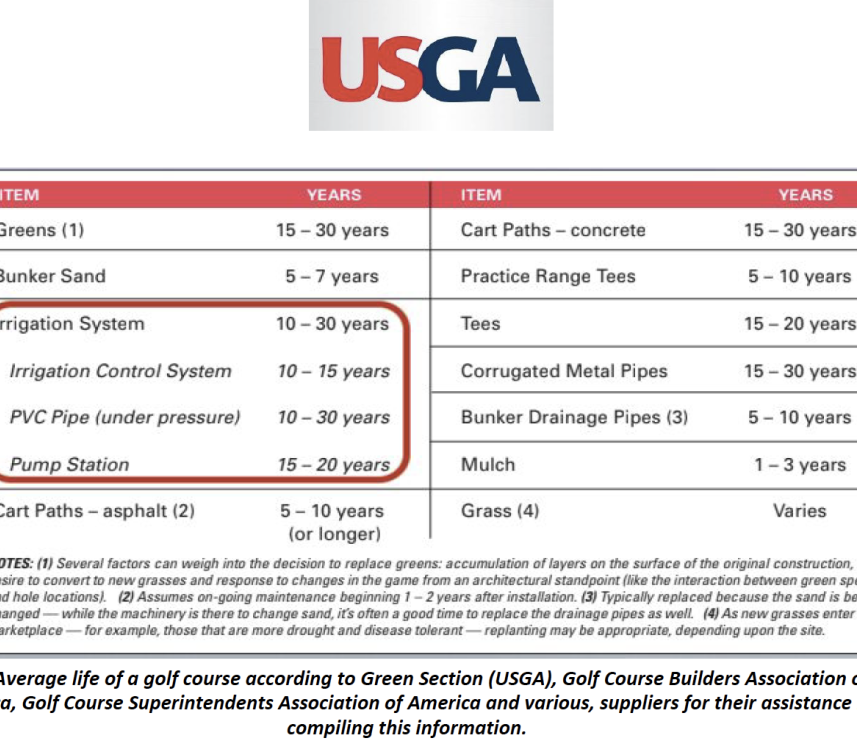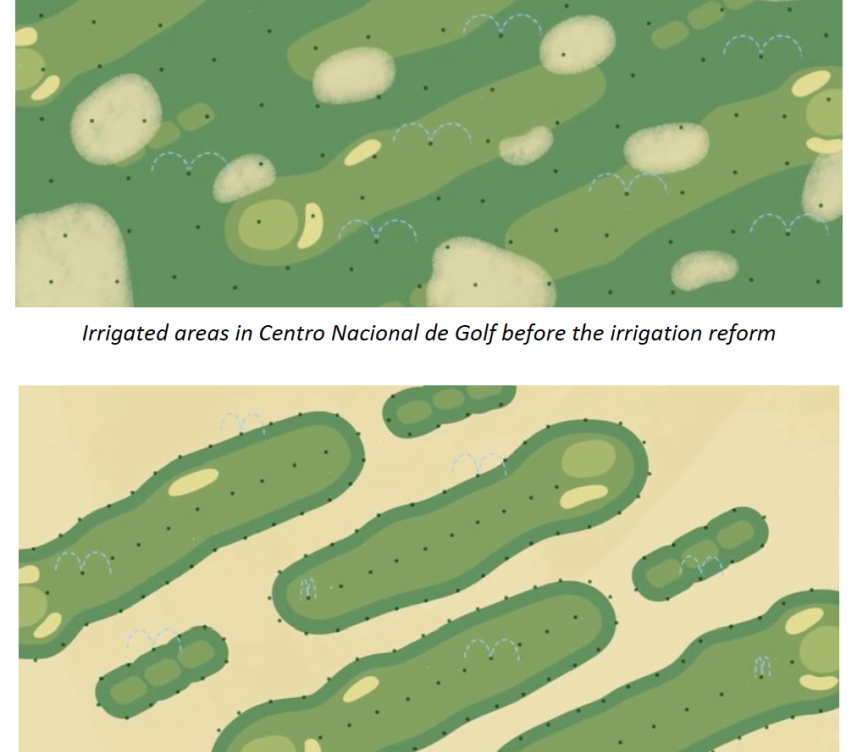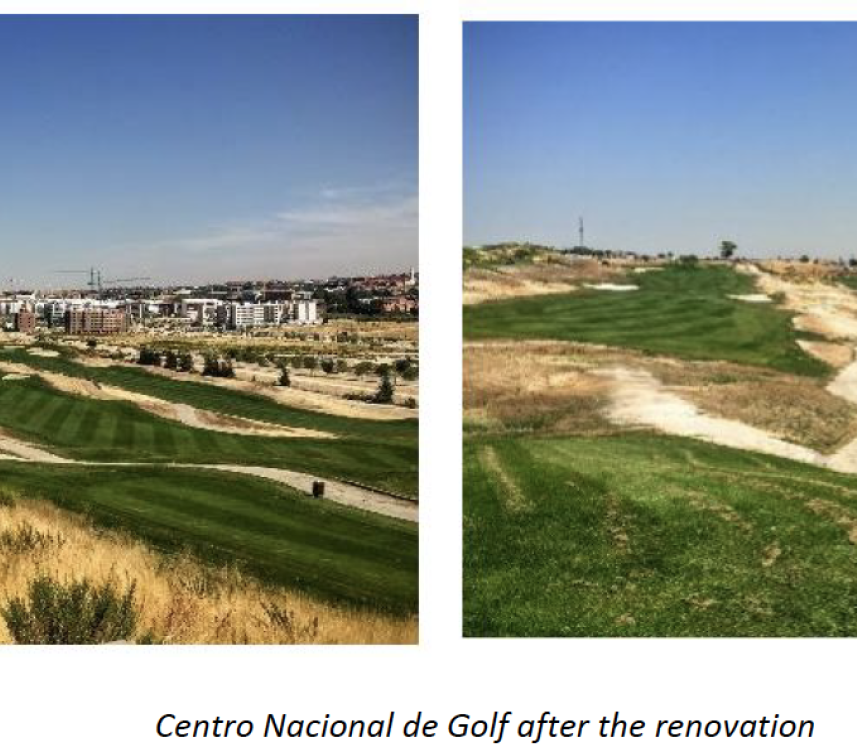

Water Use and Golf Courses - Irrigation Optimization
David Gomez - david.gomez@rfegolf.es
The consumption of water of a golf course is a big cost in the maintenance budget (especially in the south of Europe). The lack of water is a problem that affects different fields including agriculture and the environment all around the globe. It directly and significantly affects the golf course management area. This fact has made greenkeepers irrigate in a more efficient and sustainable way, taking advantage of new technologies to achieve new goals.
The management of water resources is of vital importance, for the economic cost, environmental cost and associated public image. This article presents the dialogue that justifies the change of an irrigation system in order to optimize the use of water in golf courses.
1. The Value of Water and Climate Change
The World Economic Forum has classified water crises as one of the five main global risks for nine consecutive years. Point six of the UN's sustainable development goals (SDG6) is based on improving water quality by reducing pollution, substantially increasing water-use efficiency across all sectors and ensuring sustainable withdrawals and supply of freshwater to address water scarcity and substantially reduce the number of people suffering from water scarcity.
The future of the planet depends on the sustainable management of water, but also by a commitment to recycling where wastewater is an important resource. The European Parliament has just approved the promotion of the reuse of wastewater for agricultural irrigation, as well as its extension to industry, the irrigation of gardens or for environmental purposes, provided that health and the environment are guaranteed. All this will allow the volume of reused water to increase to 6,600 million cubic meters per year by 2025, instead of the current 1,100 million.
Spain faces an unprecedented water crisis, according to the report made by Cedex (Centerfor Studies and Experimentation of Public Works) it is expected that by 2100 water resources will be reduced by 24%, and up to 40% in the most vulnerable areas. However, 10.74% of the water treated in the more than 2,000 Spanish Wastewater Treatment Plants (WWTPs) is recycled, which places Spain at the forefront in terms of water reuse.
The regenerated water was used mainly for agriculture (62%), irrigation of green areas (20%) and industry (7%). The regulations of the Community of Madrid, as well as the Tajo Hydrographic Confederation, oblige golf courses to irrigate with reclaimed water. The amount of water used in golf courses with 18 holes or more in Spain is 57.3% (regenerated water), 3.6% (desalinated water) and 38.5% (other sources).
The management of the integral water cycle through SDG6 will be one of the key factors in achieving success on the road to sustainable development.
The UN, together with Google and the Joint Research Center of the European Commission, has presented an innovative and free web platform that fuses information and environmental science in order to monitor the fresh water of the planet. This platform will allow managers and citizens to monitor in real time how their countries are progressing towards the achievement of SDG6. This is intended to make people aware of the real importance of water scarcity, which is seen as a distant issue.
Golf courses have been suffering this problem directly for many years, in a less visible way than for the population and politicians.
The increase in temperatures, the increasingly longer summers and the lack of rainfall made us change our point of view in the maintenance and irrigation system. It is essential to seek sustainability and increase the efficiency of water use by updating the irrigation system and irrigable areas, increase the number and capacity of water storage, promote the application of technological innovation and use unconventional water sources (regenerated and desalinated waters).
2. Obsolete Irrigation Systems
In irrigation systems, it is common to find facilities with obsolete designs, since numerous factors such as materials and even the game have evolved over time, especially over the last ten years, and therefore the demands have changed as well. As seen in the following table prepared by the USGA, irrigation systems should be changed as follows:
In addition, many facilities are poorly designed, there is poor maintenance, no water-energy management, and (in many cases) a lack of specialization in irrigation.
We find irrigation designs of the course without defined irrigation lines, and irregular triangulations not adapted to the terrain model, which cause numerous deficit zones and the demand for supplementary irrigation with hoses. These characteristics of the irrigation system mean that in the driest months, the course is not uniform, with large dry patches in some areas and excessive humidity in others.
It would be necessary to:
- Redesign and resize the facilities (pumping, pipes, sprinkler coverage, etc.)
- Optimize of the position in which the sprinklers are located to achieve maximum uniformity and optimization of consumption.
- Exclusive irrigation in the most used play areas: tees, fairways, around greens and greens.
- Drainage systems: where water is collected from accumulation points and stored in ponds.
- Ponds: reserve water from the field and allow us to reuse the water that comes from the drainage systems.
3. New Technology - Drones & Sensors
The use of new technologies are very important for the efficient use of water and to improve the playability of the course (meteorological stations, measurements, computer systems, etc.). The savings are focused on the cost of water and efficiency. The difference between applying these technologies can be a saving of 15 or 20%, even more if the irrigation surface is lowered.
Drones - a tool that quantifies the health of the turf with normalized difference Vegetation Index (NDVI) images and produces 3D maps, perfect for the design and development of more efficient irrigation systems and the identification of localized dry areas, flooding, or the appearance of diseases.
Humidity - temperature sensors can measure the humidity levels in soil. They are an effective tool for saving irrigation water.
4. Improvements in Golf Course Through Water Management
The responsible use of water implies greater control of the amount of water provided, avoiding excesses and misuse of water resources.
This control translates into a series of advantages, such as:
- Less disease pressure : By decreasing the humidity of the radicular profile we are controlling the conditions in which fungal diseases and pests develop. By not favoring them, the use of phytosanitary products in curative and preventive applications is also avoided.
- Better playability : greens irrigated in excess have an excessively soft surface and less wear resistance.
5. Environmental Sustainability
An efficient use of the irrigation system leads to many benefits that are not only economic.
- Implementation of new species : water conservation using grass species that require less quantity are more sustainable.
- Reducing irrigated areas - golf course definition : define the different game areas, allowing an optimum maintenance in each of them.
Watering of tees, fairways and greens. Rough naturalized without irrigation.
6. Social Awareness
The high number of golf courses that use reclaimed water not suitable for human consumption contributes to generating wealth, since the water consumed is paid for by the golf courses.
The golf sector has its best interests not only in preserving, but in improving the environment. The measures to optimize resources, contribute to the conservation of the environment, and sustainability, also mean savings for water reserves.
Raising awareness and teaching society that golf is a sport with sustainable management in environmental, social and economic matters is beneficial for golf in general.
7. Water Supply
The water suppliers (e.g. confederations and associations of irrigators) usually assign a water allocation based on estimated needs, which are getting increasingly smaller. We are now reaching cases of 6,000 m3 / ha / year when any crop irrigated triples this endowment. Therefore, it is vital to modernize and optimize irrigation systems.
8. Energy Efficiency
The energy bill is currently one of the main costs of golf courses, so having an efficient pumping system is essential. A correct design and choice of all the hydraulics elements is also very important in the energy efficiency coefficient in order to prevent the water window being higher than necessary.
9. Playability
The conditions presented by the course for the player depend directly on the operation of the irrigation system, looking for a firm and defined course, since factors such as the presence of puddles, areas without cespitose cover (dry), etc., are determined by the uniformity of the irrigation system.
10. Water Window
The configuration of the irrigation system must offer a water window that by design and configuration can irrigate the course in the shortest possible time so that they can be used for the game as many hours as possible and keep the pumping system running for the least amount of time.


